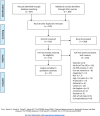The James Lind Alliance process approach: scoping review
- PMID: 31473612
- PMCID: PMC6720333
- DOI: 10.1136/bmjopen-2018-027473
The James Lind Alliance process approach: scoping review
Abstract
Objective: To summarise study descriptions of the James Lind Alliance (JLA) approach to the priority setting partnership (PSP) process and how this process is used to identify uncertainties and to develop lists of top 10 priorities.
Design: Scoping review.
Data sources: The Embase, Medline (Ovid), PubMed, CINAHL and the Cochrane Library as of October 2018.
Study selection: All studies reporting the use of JLA process steps and the development of a list of top 10 priorities, with adult participants aged 18 years.
Data extraction: A data extraction sheet was created to collect demographic details, study aims, sample and patient group details, PSP details (eg, stakeholders), lists of top 10 priorities, descriptions of JLA facilitator roles and the PSP stages followed. Individual and comparative appraisals were discussed among the scoping review authors until agreement was reached.
Results: Database searches yielded 431 potentially relevant studies published in 2010-2018, of which 37 met the inclusion criteria. JLA process participants were patients, carers and clinicians, aged 18 years, who had experience with the study-relevant diagnoses. All studies reported having a steering group, although partners and stakeholders were described differently across studies. The number of JLA PSP process steps varied from four to eight. Uncertainties were typically collected via an online survey hosted on, or linked to, the PSP website. The number of submitted uncertainties varied across studies, from 323 submitted by 58 participants to 8227 submitted by 2587 participants.
Conclusions: JLA-based PSP makes a useful contribution to identifying research questions. Through this process, patients, carers and clinicians work together to identify and prioritise unanswered uncertainties. However, representation of those with different health conditions depends on their having the capacity and resources to participate. No studies reported difficulties in developing their top 10 priorities.
Keywords: James Lind Alliance; patient and public involvement; patient involvement in research; priority setting partnership.
© Author(s) (or their employer(s)) 2019. Re-use permitted under CC BY-NC. No commercial re-use. See rights and permissions. Published by BMJ.
Conflict of interest statement
Competing interests: None declared.
Figures
Similar articles
-
Exploring the challenge of health research priority setting in partnership: reflections on the methodology used by the James Lind Alliance Pressure Ulcer Priority Setting Partnership.Res Involv Engagem. 2016 Apr 2;2:12. doi: 10.1186/s40900-016-0026-y. eCollection 2016. Res Involv Engagem. 2016. PMID: 29062513 Free PMC article.
-
Adapting the James Lind Alliance priority setting process to better support patient participation: an example from cystic fibrosis.Res Involv Engagem. 2019 Aug 20;5:24. doi: 10.1186/s40900-019-0159-x. eCollection 2019. Res Involv Engagem. 2019. PMID: 31452934 Free PMC article.
-
Research priorities in children requiring elective surgery for conditions affecting the lower limbs: a James Lind Alliance Priority Setting Partnership.BMJ Open. 2019 Dec 30;9(12):e033233. doi: 10.1136/bmjopen-2019-033233. BMJ Open. 2019. PMID: 31892663 Free PMC article.
-
A proposed methodology for uncertainty extraction and verification in priority setting partnerships with the James Lind Alliance: an example from the Common Conditions Affecting the Hand and Wrist Priority Setting Partnership.BMC Med Res Methodol. 2022 Nov 10;22(1):292. doi: 10.1186/s12874-022-01777-5. BMC Med Res Methodol. 2022. PMID: 36357847 Free PMC article. Review.
-
Identifying trial recruitment uncertainties using a James Lind Alliance Priority Setting Partnership - the PRioRiTy (Prioritising Recruitment in Randomised Trials) study.Trials. 2018 Mar 1;19(1):147. doi: 10.1186/s13063-018-2544-4. Trials. 2018. PMID: 29490702 Free PMC article.
Cited by
-
Use of environmental scans in health services delivery research: a scoping review.BMJ Open. 2021 Nov 10;11(11):e050284. doi: 10.1136/bmjopen-2021-050284. BMJ Open. 2021. PMID: 34758992 Free PMC article.
-
Enhancing evidence-informed policymaking in medicine and healthcare: stakeholder involvement in the Commons Project for rare diseases in Japan.Res Involv Engagem. 2023 Nov 29;9(1):107. doi: 10.1186/s40900-023-00515-5. Res Involv Engagem. 2023. PMID: 38031179 Free PMC article.
-
Interventions to reduce infections in patients with hematological malignancies: a systematic review and meta-analysis.Blood Adv. 2023 Jan 10;7(1):20-31. doi: 10.1182/bloodadvances.2022008073. Blood Adv. 2023. PMID: 35882473 Free PMC article.
-
Needs-led research: a way of employing user involvement when devising research questions on the trust model in community home-based health care services in Norway.Res Involv Engagem. 2021 Jun 22;7(1):43. doi: 10.1186/s40900-021-00291-0. Res Involv Engagem. 2021. PMID: 34158122 Free PMC article.
-
Overarching Priorities for Health and Care Research in the United Kingdom: A Coproduced Synthesis of James Lind Alliance 'Top 10s'.Health Expect. 2024 Jun;27(3):e14096. doi: 10.1111/hex.14096. Health Expect. 2024. PMID: 38895996 Free PMC article.
References
-
- Hanley B, Bradburn J, Barnes M, et al. . Involving the public in NHS public health, and social care research: Briefing notes for researchers. UK: Involve 2004;2:1–61.
Publication types
MeSH terms
LinkOut - more resources
Full Text Sources
Medical
Miscellaneous

